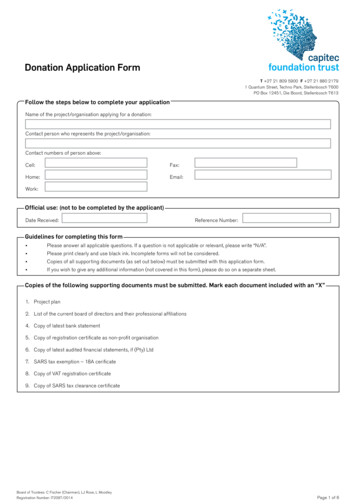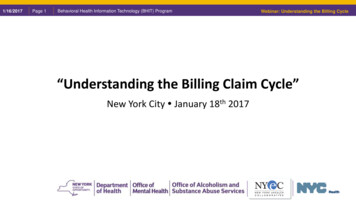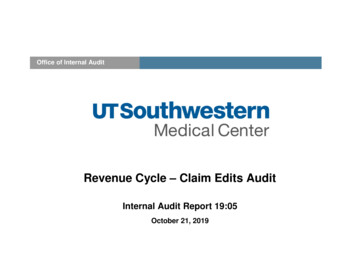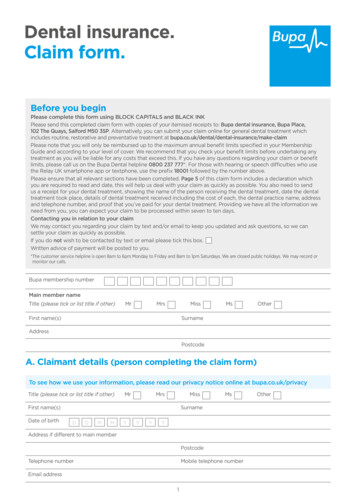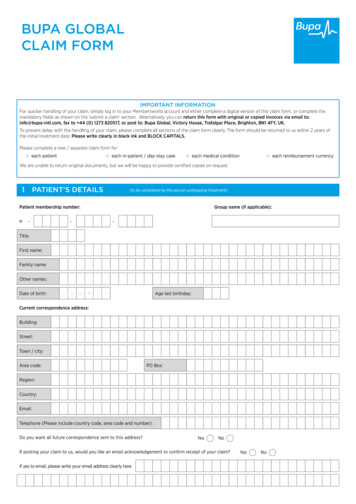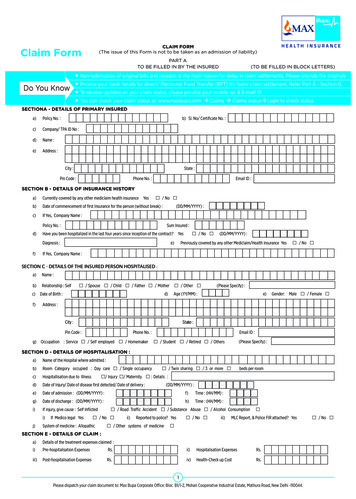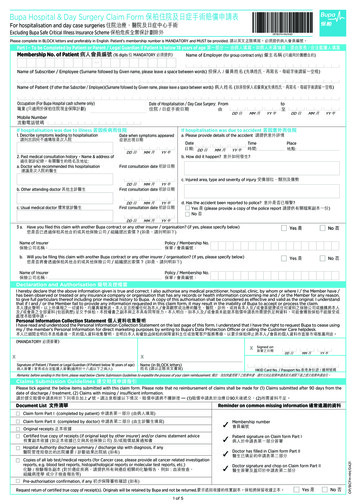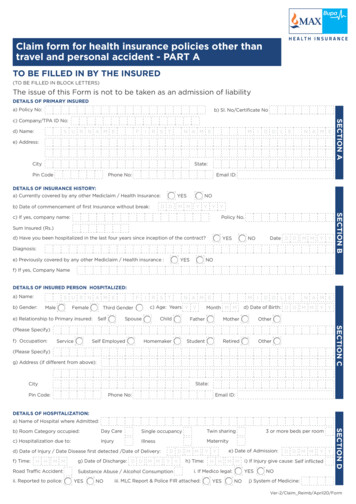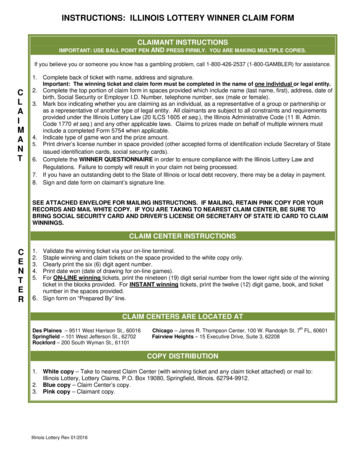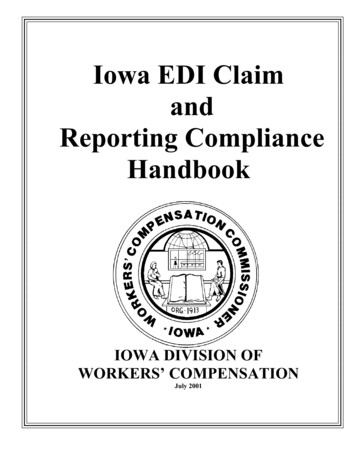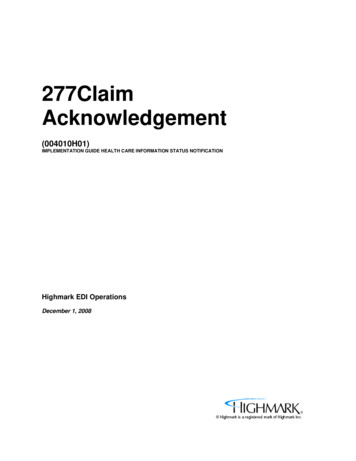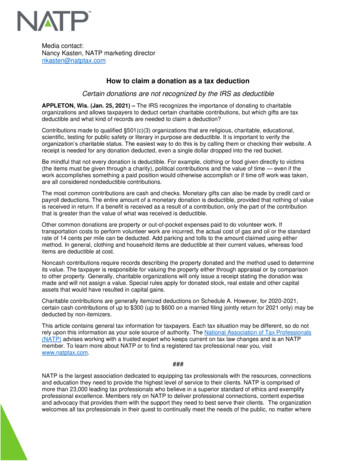
Transcription
Media contact:Nancy Kasten, NATP marketing directornkasten@natptax.comHow to claim a donation as a tax deductionCertain donations are not recognized by the IRS as deductibleAPPLETON, Wis. (Jan. 25, 2021) – The IRS recognizes the importance of donating to charitableorganizations and allows taxpayers to deduct certain charitable contributions, but which gifts are taxdeductible and what kind of records are needed to claim a deduction?Contributions made to qualified §501(c)(3) organizations that are religious, charitable, educational,scientific, testing for public safety or literary in purpose are deductible. It is important to verify theorganization’s charitable status. The easiest way to do this is by calling them or checking their website. Areceipt is needed for any donation deducted, even a single dollar dropped into the red bucket.Be mindful that not every donation is deductible. For example, clothing or food given directly to victims(the items must be given through a charity), political contributions and the value of time — even if thework accomplishes something a paid position would otherwise accomplish or if time off work was taken,are all considered nondeductible contributions.The most common contributions are cash and checks. Monetary gifts can also be made by credit card orpayroll deductions. The entire amount of a monetary donation is deductible, provided that nothing of valueis received in return. If a benefit is received as a result of a contribution, only the part of the contributionthat is greater than the value of what was received is deductible.Other common donations are property or out-of-pocket expenses paid to do volunteer work. Iftransportation costs to perform volunteer work are incurred, the actual cost of gas and oil or the standardrate of 14 cents per mile can be deducted. Add parking and tolls to the amount claimed using eithermethod. In general, clothing and household items are deductible at their current values, whereas fooditems are deductible at cost.Noncash contributions require records describing the property donated and the method used to determineits value. The taxpayer is responsible for valuing the property either through appraisal or by comparisonto other property. Generally, charitable organizations will only issue a receipt stating the donation wasmade and will not assign a value. Special rules apply for donated stock, real estate and other capitalassets that would have resulted in capital gains.Charitable contributions are generally itemized deductions on Schedule A. However, for 2020-2021,certain cash contributions of up to 300 (up to 600 on a married filing jointly return for 2021 only) may bededucted by non-itemizers.This article contains general tax information for taxpayers. Each tax situation may be different, so do notrely upon this information as your sole source of authority. The National Association of Tax Professionals(NATP) advises working with a trusted expert who keeps current on tax law changes and is an NATPmember. To learn more about NATP or to find a registered tax professional near you, visitwww.natptax.com.###NATP is the largest association dedicated to equipping tax professionals with the resources, connectionsand education they need to provide the highest level of service to their clients. NATP is comprised ofmore than 23,000 leading tax professionals who believe in a superior standard of ethics and exemplifyprofessional excellence. Members rely on NATP to deliver professional connections, content expertiseand advocacy that provides them with the support they need to best serve their clients. The organizationwelcomes all tax professionals in their quest to continually meet the needs of the public, no matter where
they are in their careers. The NATP headquarters is located in Appleton, WI. To learn more, visitwww.natptax.com.
Media contact:Nancy Kasten, NATP marketing directornkasten@natptax.comMilitary personnel may receive additional tax benefits for 2020 returnsAPPLETON, Wis. (Jan. 25, 2021) – Members of the military and their families may be eligible forspecial tax benefits on their 2020 tax returns. For federal tax purposes, the U.S. Armed Forces includeenlisted personnel in all regular and reserve units controlled by the Secretaries of Defense — the AirForce, Army, Coast Guard and Navy.Travel expenses can be deducted if they are unreimbursed and are incurred while traveling away fromhome. Homes of members of the U.S. Armed Forces are considered their duty station if on a permanentduty assignment. To be deductible, the travel expenses must be work-related. Military personnel cannotdeduct any expenses for personal travel, such as visits to family on leave. If part of the Reserves,unreimbursed travel expenses for traveling more than 100 miles from home to perform reserve duties areeligible for deduction. They do not have to itemize deductions since eligible expenses are deducted as anadjustment to income. The standard mileage rate is 57.5 cents for 2020 and 56 cents for 2021.Uniform purchase cost and future upkeep deductibility depend on whether the uniform can be worn whenoff duty. If the uniform can be worn while off duty, no costs can be deducted. However, if the uniform isprohibited from being worn when off duty, the cost associated with that uniform may be deducted. Thefollowing are deductible: Military battle dress uniforms and utility uniforms that cannot be worn while off-dutyArticles not replacing regular clothing, including insignia of rank, corps devices, epaulets,aiguillettes and swordsMoving expenses have special rules that apply to active-duty members of the U.S. Armed Forces andtheir surviving spouses who move due to a permanent station change. Deductible expenses includeunreimbursed costs of moving, travel and storing and insuring personal items including household goods.Distributions from an IRA, 401(k) or 403(b) plans made after the date of the order or call to active dutyand before the close of the active-duty period have special rules and may not be subject to the 10 percentpenalty tax on early distributions. Such distributions are also eligible to be repaid to the plan if paid backwithin two years of ending active duty.This article contains general tax information for taxpayers. Each tax situation may be different, so do notrely upon this information as the sole source of authority. The National Association of Tax Professionals(NATP) advises working with a trusted expert who keeps current on tax law changes and is an NATPmember. To learn more about NATP or to find a local, registered tax professional, visit www.natptax.com.###NATP is the largest association dedicated to equipping tax professionals with the resources, connectionsand education they need to provide the highest level of service to their clients. NATP is comprised ofmore than 23,000 leading tax professionals who believe in a superior standard of ethics and exemplifyprofessional excellence. Members rely on NATP to deliver professional connections, content expertiseand advocacy that provides them with the support they need to best serve their clients. The organizationwelcomes all tax professionals in their quest to continually meet the needs of the public, no matter wherethey are in their careers. The NATP headquarters is located in Appleton, WI. To learn more, visitwww.natptax.com.
Media contact:Nancy Kasten, NATP Marketing Directornkasten@natptax.comGig economy workers may face tax implications for 2020 returnsNATP advises opening separate business bank account to track deductible expensesAPPLETON, Wis. (Jan. 25, 2021) – Picking up a second job to supplement household income iscommon – especially as many Americans deal with the fallout of COVID-19. Many are choosing tobecome gig economy workers who perhaps deliver on-demand food from restaurants and grocery storesor packages from online retailers. Some may not realize the tax implications of becoming a sole proprietorand what they need to do to file taxes.Conducting business as a sole proprietor is one of the simplest forms of operation. It’s easy to start abusiness operated as a sole proprietorship and equally as easy to discontinue. The first step whenstarting a business is to open a separate business checking account. It will be easier to track thedeductible expenses if they are not commingled with personal expenses. If the taxpayer incurredexpenses prior to opening their business, they should keep them separate from their other expenses.Special tax treatment applies to startup expenses.It is important to keep track of the business mileage, as it may be eligible for deduction. If the taxpayer isself-employed and maintains an eligible office in their home, they can deduct the mileage to and fromtheir client/customer’s place of business, as well as between jobs.There are two ways to calculate auto deductions: the standard mileage rate or actual expenses. Thestandard mileage rate is the easier method and can be calculated by multiplying total business mileageby the current rate ( .57 ½ for 2020 and .56 for 2021). The actual expense method is exactly that,recording the actual expenses such as the cost of gas, oil, insurance, repairs, maintenance, tires,washing, licenses and depreciation. This method requires the taxpayer to keep very detailed records andif they use their car for personal and business purposes, they will have to divide the expenses betweenthe personal and business portion.The IRS allows self-employed taxpayers to claim a deduction for home-based business expenses if theymeet certain requirements. They must use the home office regularly and exclusively: As the principal place of business for their trade or businessAs a place to meet with customers in the normal course of their trade or businessIn connection with their trade or business, if the location is in a separate structure that’s notattached to the dwelling unit.Similar to the auto deduction, there are two ways to compute the home office deduction: the simplifiedmethod or the traditional method. The simplified method allows taxpayers to deduct 5 per square foot,up to a maximum of 300 square feet, for their home office. The traditional method allows taxpayers todeduct all the direct costs associated with their home office, as well as a portion of the indirect costs.This article contains general tax information for taxpayers. Each tax situation may be different, so do notrely upon this information as the sole source of authority. The National Association of Tax Professionals(NATP) advises working with a tax expert in the local area who keeps current on tax law changes and isalso an NATP member.To learn more about NATP or find a tax professional in your area, visit www.natptax.com.###NATP is the largest association dedicated to equipping tax professionals with the resources, connections,and education they need to provide the highest level of service to their clients. NATP is comprised ofmore than 23,000 leading tax professionals who believe in a superior standard of ethics and exemplify
professional excellence. Members rely on NATP to deliver professional connections, content expertiseand advocacy that provides them with the support they need to best serve their clients. The organizationwelcomes all tax professionals in their quest to continually meet the needs of the public, no matter wherethey are in their careers. The NATP headquarters is located in Appleton, WI. To learn more, visitwww.natptax.com.
Media contact:Nancy Kasten, NATP marketing directornkasten@natptax.comIRS deadline approaching for small, non-profit organizationsDeadline includes sports clubs, civic organizations and local associationsAPPLETON, Wis. (Jan. 25, 2021) – Even small non-profit organizations, such as sports clubs, civicorganizations and local associations, are required to file a yearly report with the IRS. By law, the IRS willautomatically revoke the federal tax-exempt status of organizations that fail to file annual reports for threeconsecutive years. However, churches and church-related organizations are not required to file annualreports unless they have unrelated business taxable income.The Form 990-series information returns and notices are due on the 15th day of the fifth month after anorganization’s tax year ends. Many organizations use the calendar year as their tax year, making May 17,2021, the deadline to file for 2020 since it’s the next business day after May 15, 2021.The IRS offers an online search tool called Tax Exempt Organization Search. This helps users easily findkey information about the federal tax status and filings of certain tax-exempt organizations, includingwhether an organization has had its federal tax exemption automatically revoked.This article contains general tax information for taxpayers. Each tax situation may be different, so do notrely upon this information as the sole source of authority. The National Association of Tax Professionals(NATP) advises working with a trusted expert who keeps current on tax law changes and is an NATPmember. To learn more about NATP or to find a local, registered tax professional, visit www.natptax.com.###The National Association of Tax Professionals (NATP) is the largest association dedicated to equipping taxprofessionals with the resources, connections and education they need to provide the highest level ofservice to their clients. NATP is comprised of more than 23,000 leading tax professionals who believe in asuperior standard of ethics and exemplify professional excellence. Members rely on NATP to deliverprofessional connections, content expertise and advocacy that provides them with the support they needto best serve their clients. The organization welcomes all tax professionals in their quest to continuallymeet the needs of the public, no matter where they are in their careers. The NATP headquarters is locatedin Appleton, WI. To learn more, visit www.natptax.com.
Media contact:Nancy Kasten, NATP marketing directornkasten@natptax.comThe importance of meeting with a qualified tax professionalWhat to bring to the annual appointmentAPPLETON, Wis. (Jan. 26, 2021) – With the filing season quickly approaching, it is important to contacta tax professional early to reserve a convenient time for an appointment. Tax returns can be done moreaccurately and in a shorter period of time if the taxpayer brings all of the information to the initialappointment.Taxpayers should start preparing early for the tax appointment by compiling a list of the documents theyexpect to receive based on last tax year’s statements and this tax year’s activities. This year, if possibleand applicable, taxpayers should bring their Notice 1444 and Notice 1444-B. These notices listed theamount they received as a stimulus payment(s) and when the payment was deposited into their account.Call the tax preparer with any questions about necessary documents needed. When the documents startcoming in the mail or electronically (usually around the end of January), mark them off a list and put themin a tax folder with the list to stay organized.If employed, the taxpayer will need to include their W-2. If they received income from interest, dividends,pensions, self-employment, government payments or the sale of property, they would receive a Form1099. It is helpful to bring the actual statements to the appointment. Remember that not all forms will lookalike. Furthermore, issuers can create their own substitute 1099s that may look entirely different than theofficial IRS version of 1099s. Somewhere on the envelope, on the form or in the email, it must clearlystate it is an important tax document. Also, the taxpayer should not forget to include any Schedule K-1sthey receive from a partnership, an S corporation, trust or estate. If the taxpayer had any income notreported on the forms listed above, it’s important to make a note for the tax preparer to include it.If stock was sold during the year, the taxpayer will receive a 1099-B as described above that includes thegross proceeds. However, the price paid for the stock and the cost basis may not be listed on the 1099-B.Generally, the cost basis is the purchase price of the stock. If the stock was received as a gift orinheritance, other means of determining the cost will be necessary. For every stock sold, include thebasis for the tax professional to calculate the net gain/loss.If a taxpayer owns a home, they might be able to itemize deductions. Each year bring the property tax billand the mortgage interest statement to the tax appointment. Medical expenses are deductible if theyexceed 10 percent of the adjusted gross income (AGI). Applicable medical expenses include: prescriptiondrugs, doctor, dental, hospital bills, medical insurance premiums not paid on a pre-tax basis through thetaxpayer’s employer and the mileage to and from the doctor’s office. Charitable contributions are a goodsource of deductions. Contributions can be cash, property or out-of-pocket expenses paid to do volunteerwork. If the taxpayer drove to and from the volunteer work, they can take the actual cost of gas and oil oruse the standard rate of 14 cents-per-mile. The taxpayer will need a receipt for any donation they claim.This article contains general tax information for taxpayers. Each tax situation may be different, so do notrely upon this information as the sole source of authority. The National Association of Tax Professionals(NATP) advises working with a trusted expert who keeps current on tax law changes and is an NATPmember. To learn more about NATP or to find a local, registered tax professional, visit www.natptax.com.###NATP is the largest association dedicated to equipping tax professionals with the resources, connectionsand education they need to provide the highest level of service to their clients. NATP is comprised of
more than 23,000 leading tax professionals who believe in a superior standard of ethics and exemplifyprofessional excellence. Members rely on NATP to deliver professional connections, content expertiseand advocacy that provides them with the support they need to best serve their clients. The organizationwelcomes all tax professionals in their quest to continually meet the needs of the public, no matter wherethey are in their careers. The NATP headquarters is located in Appleton, WI. To learn more, visitwww.natptax.com.
Media contact:Nancy Kasten, NATP marketing directornkasten@natptax.comDivorced couples should note alimony changes under TCJAAlimony no longer tax deductibleAPPLETON, Wis. (Jan. 25, 2021) – Determining the tax consequences that can arise during a divorce ormarital separation can be vital for the financial protection and well-being of the taxpayer and their family.That’s why it’s important to understand applicable tax laws before making any major decisions.One of the most confusing tasks during the divorce process is determining whether a payment should beconsidered alimony or child support. Generally, alimony is the amount paid to a spouse for their livingexpenses, education, health or life insurance, property taxes or mortgage payment. Alimony is not forproviding child support.Under the Tax Cuts and Jobs Act (TCJA), alimony is not tax deductible. Furthermore, it is not included inthe recipient’s gross income. The TCJA rules apply to divorces and legal separations executed after2018, meaning the alimony-paying spouse cannot deduct the payments and the alimony-receivingspouse doesn’t include them in gross income.In general, the TCJA rules do not apply to existing divorces and separations executed before 2019. If theTCJA rules don’t apply, the old rules continue to apply. In this case, the person receiving alimony must paytaxes on the payments received during the year and the paying spouse may deduct the amount paidduring the year, provided the payment meets the following conditions: The payment is made in cash or cash equivalent, which includes checks, bank deposits, etc.Payments in the form of bonds, stocks, money market shares or actual objects are notconsidered alimony for tax purposes.The payment is made as the result of a legal separation agreement or divorce decree.The spouses do not live in the same household at the time the payment is made.The divorce decree does not designate the payment as nontaxable to the recipient ornondeductible by the payer.There can be no liability for payments after the death of the receiving spouse.Child support, unlike alimony, is not taxable to the spouse who received the payment, nor is it taxdeductible by the spouse who makes the payment. A divorce decree may specifically call the payment“alimony,” but the payment may have the characteristics of child support, for example, the designation inthe divorce document that the payment changes or terminates at certain milestones in the child’s life.Tax challenges during and following a divorce are common, but they can be minimized with someknowledge about tax laws and IRS procedures. Financial planning is an important part of the divorceprocess.This article contains general tax information for taxpayers. Each tax situation may be different, so do notrely upon this information as a sole source of authority. The National Association of Tax Professionals(NATP) advises working with a trusted expert who keeps current on tax law changes and is an NATPmember. To learn more about NATP or to find a local, registered tax professional, visit www.natptax.com.###
NATP is the largest association dedicated to equipping tax professionals with the resources, connectionsand education they need to provide the highest level of service to their clients. NATP is comprised ofmore than 23,000 leading tax professionals who believe in a superior standard of ethics and exemplifyprofessional excellence. Members rely on NATP to deliver professional connections, content expertiseand advocacy that provides them with the support they need to best serve their clients. The organizationwelcomes all tax professionals in their quest to continually meet the needs of the public, no matter wherethey are in their careers. The NATP headquarters is located in Appleton, WI. To learn more, visitwww.natptax.com.
Media contact:Nancy Kasten, NATP marketing directornkasten@natptax.comNATP warns taxpayers, tax pros of fake IRS scamsScammers send fake IRS notices, lure unsuspecting victimsAPPLETON, Wis. (Jan. 26, 2021) – Every year, taxpayers are bombarded with emails and lettersclaiming to be from the IRS and asking for personal information. The subject titles on many of theseemails claim that the IRS is trying to contact the person because they have a refund for them. These arecommonly referred to as phishing scams.Phishing is a term used to describe emails that are “fishing for information” and “hooking” victims. Thecontent of these messages lure readers into believing that the IRS needs information from them. The IRShas issued several recent consumer warnings on the fraudulent use of the IRS name or logo byscammers trying to gain access to consumers’ financial information to steal their identity and assetsthrough emails and letters.These scam messages are used to trick readers into providing sensitive information. Fraudsters typicallyrequest bank information or credit card numbers so readers can pay their tax due or receive their refunds.Unsuspecting persons are now victims of identity theft.The IRS will never request financial information, passwords, PINs or any other sensitive information fromanyone via email. The IRS sends paper notices to taxpayers to discuss tax account information. Neverprovide bank information to someone via email.Do not reply to these phishing emails. Do not open any attachments — they might contain malicious codethat could infect the computer. Also, do not click any links provided in the email. These websites couldalso give the computer a virus or malware.This article contains general tax information for taxpayers. Each tax situation may be different, so do notrely upon this information as a sole source of authority. The National Association of Tax Professionals(NATP) advises working with a trusted expert who keeps current on tax law changes and is an NATPmember. To learn more about NATP or to find a local, registered tax professional, visit www.natptax.com.###NATP is the largest association dedicated to equipping tax professionals with the resources, connectionsand education they need to provide the highest level of service to their clients. NATP is comprised ofmore than 23,000 leading tax professionals who believe in a superior standard of ethics and exemplifyprofessional excellence. Members rely on NATP to deliver professional connections, content expertiseand advocacy that provides them with the support they need to best serve their clients. The organizationwelcomes all tax professionals in their quest to continually meet the needs of the public, no matter wherethey are in their careers. The NATP headquarters is located in Appleton, WI. To learn more, visitwww.natptax.com.
Media contact:Nancy Kasten, NATP marketing directornkasten@natptax.comE-filed returns on the rise for 2021Mailed returns to be significantly delayed for processingAPPLETON, Wis. (Jan. 26, 2021) – Considering the impacts of COVID-19, the IRS is expecting a surgein e-filed returns. Of all the federal tax returns filed in 2013, 77 percent were filed electronically. Thisnumber jumped to 90 percent in 2019. Those who don’t e-file are now the exception.Why would almost 152 million taxpayers choose to e-file? There’s no waiting in line at the post office, noworrying if a return reached its destination and no need to write a check. Tax due can be paid by usingthe Electronic Federal Tax Payment System (EFTPS). Electronic payment options are convenient andsecure. E-filing allows taxpayers to submit a return to the IRS in a quick, accurate and efficient way.Taxpayers don’t need to worry about attaching specific documents to certain pages or if the person at theIRS correctly keyed in the return. In addition, e-filed returns are processed more quickly, which results ina quicker turnaround time.E-filing is also beneficial for the IRS as it costs significantly less to process an e-filed return than a paperone – an issue that was highlighted when the effects of COVID-19 hit. Computer processed e-filed federalreturns consequently have fewer errors than the human processed paper returns.This article contains general tax information for taxpayers. Each tax situation may be different, so do notrely upon this information as the sole source of authority. The National Association of Tax Professionals(NATP) advises working with a trusted expert who keeps current on tax law changes and is an NATPmember. To learn more about NATP or to find a local, registered tax professional, visit www.natptax.com.###NATP is the largest association dedicated to equipping tax professionals with the resources, connectionsand education they need to provide the highest level of service to their clients. NATP is comprised ofmore than 23,000 leading tax professionals who believe in a superior standard of ethics and exemplifyprofessional excellence. Members rely on NATP to deliver professional connections, content expertiseand advocacy that provides them with the support they need to best serve their clients. The organizationwelcomes all tax professionals in their quest to continually meet the needs of the public, no matter wherethey are in their careers. The NATP headquarters is located in Appleton, WI. To learn more, visitwww.natptax.com.
Media contact:Nancy Kasten, NATP marketing directornkasten@natptax.comIncorrect Social Security numbers top list of most common tax mistakesRejected returns can delay refund several weeks, monthsAPPLETON, Wis. (Jan. 25, 2021) – At the close of each tax filing season, the Internal Revenue Service(IRS) compiles a list of the most common errors taxpayers make when filing their tax returns. Believe itor not, incorrect mathematical calculations are not the number one error. The most frequent culprit forthe past several years is submitting incorrect Social Security numbers on individual income tax returns.When an incorrect return is filed, the IRS first “rejects” it, then sends a notice to the taxpayer requestingadditional information. This can delay a refund by several weeks, or even months. In other instances, theIRS may issue a refund, but for a lesser amount than what the taxpayer was expecting. This may occurwhen a claimed dependent has a missing or incorrect Social Security number, or when another taxpayerclaims the same dependent.Another reason a taxpayer may receive a reduced refund is if they are eligible to claim a tax credit forchild and dependent care expenses but do not include the Social Security number or TaxpayerIdentification Number of their caregiver on the tax return. The IRS will issue the refund, less the amount ofthe credit. The taxpayer will then have to file an amended return and wait several more weeks for the restof their money. All this can be avoided if care is given when entering required information on a return.Other details to keep in mind when filing taxes this year include: If paper filing, sign the return in the proper places. If filing a joint tax return with a spouse, bothmust sign. If one spouse has passed away during the year, the surviving spouse must write“Deceased,” the spouse’s name and the date of death across the top of the return, above thearea where the address is entered. The surviving spouse should also sign the return and write“filing as surviving spouse” in the signature area below their signature.For proper filing, attach Copy B of all Forms W-2 received during the year to the federal return.Also, attach any Forms 1099 that report tax withholding. For electronic filing, all appropriate FormW-2 or Form 1099 information should be entered on the input form, which is
Special tax treatment applies to startup expenses. It is important to keep track of the business mileage, as it may be eligible for deduction. If the taxpayer is self-employed and maintains an eligible office in their home, they can deduct the mileage to and from their clie
